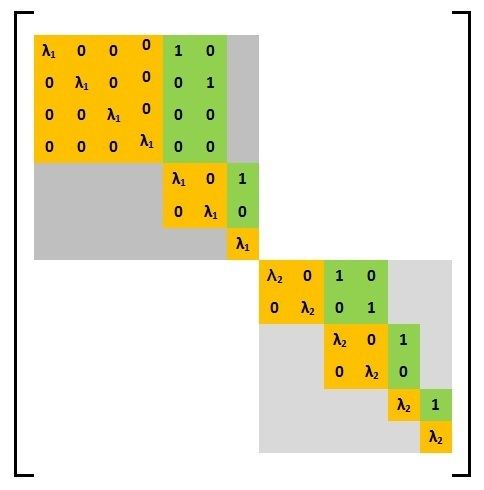 | ||
In mathematics, in linear algebra, a Weyr canonical form (or, Weyr form or Weyr matrix) is a square matrix satisfying certain conditions. A square matrix is said to be in the Weyr canonical form if the matrix satisfies the conditions defining the Weyr canonical form. The Weyr form was discovered by the Czech mathematician Eduard Weyr in 1885. The Weyr form did not become popular among mathematicians and it was overshadowed by the closely related, but distinct, canonical form known by the name Jordan canonical form. The Weyr form has been rediscovered several times since Weyr’s original discovery in 1885. This form has been variously called as modified Jordan form, reordered Jordan form, second Jordan form, and H-form. The current terminology is credited to Shapiro who introduced it in a paper published in the American Mathematical Monthly in 1999.
Contents
- Definition
- Example
- The Weyr form is canonical
- Reduction to the nilpotent case
- Reduction of a nilpotent matrix to the Weyr form
- Applications of the Weyr form
- References
Recently several applications have been found for the Weyr matrix. Of particular interest is an application of the Weyr matrix in the study of phylogenetic invariants in biomathematics.
Definition
A basic Weyr matrix with eigenvalue
such that, when
- The main diagonal blocks
W i i n i × n i λ I fori = 1 , … , r . - The first superdiagonal blocks
W i , i + 1 n i × n i + 1 i = 1 , … , r − 1 . - All other blocks of W are zero (that is,
W i j = 0 whenj ≠ i , i + 1 ).
In this case, we say that
Example
The following is an example of a basic Weyr matrix.
In this matrix,
and
Definition
Let
where
Example
The following image shows an example of a general Weyr matrix consisting of three basic Weyr matrix blocks. The basic Weyr matrix in the top-left corner has the structure (4,2,1) with eigenvalue 4, the middle block has structure (2,2,1,1) with eigenvalue -3 and the one in the lower-right corner has the structure (3, 2) with eigenvalue 0.
The Weyr form is canonical
That the Weyr form is a canonical form of a matrix is a consequence of the following result: Each square matrix
Reduction to the nilpotent case
Let
where
Reduction of a nilpotent matrix to the Weyr form
Given a nilpotent square matrix
Step 1
Let
Step 2
- Compute a basis for the null space of
A 1 - Extend the basis for the null space of
A 1 n -dimensional vector spaceF n - Form the matrix
P 1 - Compute
P 1 − 1 A 1 P 1 = [ 0 B 2 0 A 2 ] .A 2 n − nullity( A 1 ) .
Step 3
If
- Compute a basis for the null space of
A 2 - Extend the basis for the null space of
A 2 n − nullity( A 1 ) . - Form the matrix
P 2 - Compute
P 2 − 1 A 2 P 2 = [ 0 B 3 0 A 3 ] .A 2 n − nullity( A 1 ) − nullity( A 2 ) .
Step 4
Continue the processes of Steps 1 and 2 to obtain increasingly smaller square matrices
Step 5
The Weyr structure of
Step 6
- Compute the matrix
P = P 1 [ I 0 0 P 2 ] [ I 0 0 P 3 ] ⋯ [ I 0 0 P r ] (here theI 's are appropriately sized identity matrices). - Compute
X = P − 1 A P .X is a matrix of the following form:
Step 7
Use elementary row operations to find an invertible matrix
Step 8
Set
Step 9
Find a matrix
Step 10
Repeat Steps 8 and 9 on column
Step 11
Repeat these processes on
Step 12
Let
Applications of the Weyr form
Some well-known applications of the Weyr form are listed below:
- The Weyr form can be used to simplify the proof of Gerstenhaber’s Theorem which asserts that the subalgebra generated by two commuting
n × n matrices has dimension at mostn . - A set of finite matrices is said to be approximately simultaneously diagonalizable if they can be perturbed to simultaneously diagonalizable matrices. The Weyr form is used to prove approximate simultaneous diagonalizability of various classes of matrices. The approximate simultaneous diagonalizability property has applications in the study of phylogenetic invariants in biomathematics.
- The Weyr form can be used to simplify the proofs of the irreducibility of the variety of all k-tuples of commuting complex matrices.
